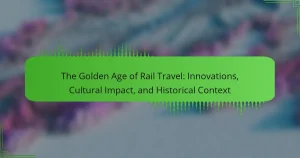The future of transportation is being reshaped by emerging technologies, sustainability initiatives, and global trends. Innovations like electric vehicles and autonomous driving enhance safety and efficiency. Sustainability drives the adoption of eco-friendly practices and smart infrastructure. Key nations lead in these advancements, setting benchmarks for a more sustainable and efficient transportation landscape.
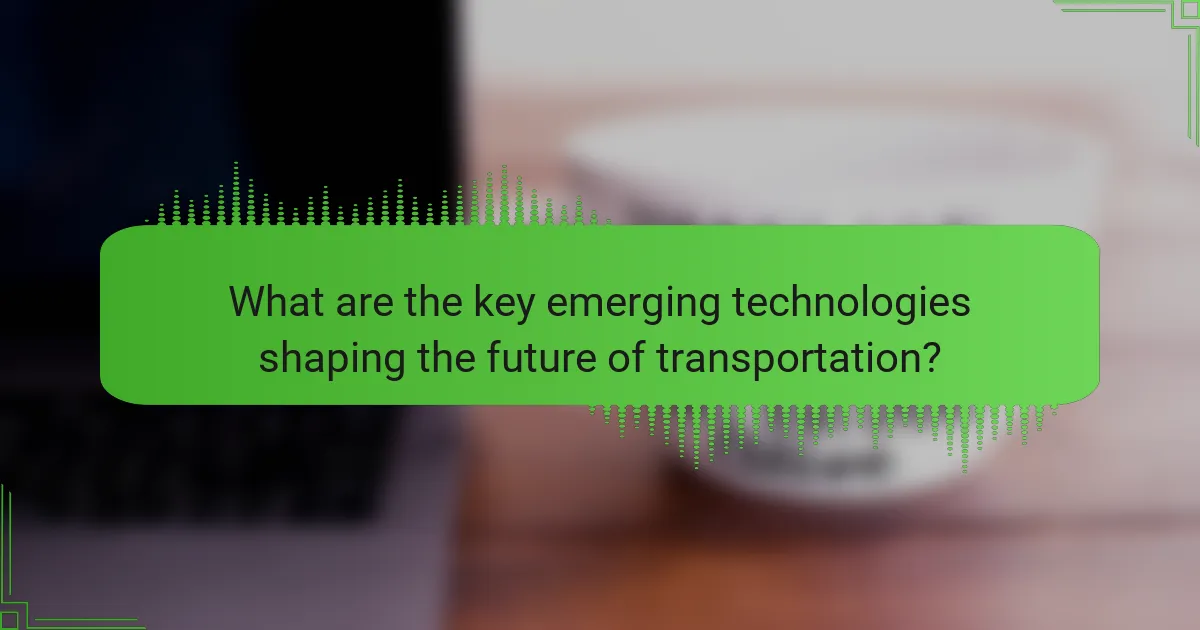
What are the key emerging technologies shaping the future of transportation?
Key emerging technologies shaping the future of transportation include electric vehicles, autonomous driving, and smart infrastructure. These innovations enhance sustainability, improve safety, and optimize traffic management. Electric vehicles reduce carbon emissions significantly, while autonomous systems promise to decrease accidents and improve efficiency. Smart infrastructure integrates data and connectivity to streamline urban mobility and reduce congestion.
How is electric vehicle technology evolving?
Electric vehicle technology is rapidly evolving through advancements in battery efficiency, autonomous driving, and charging infrastructure. Innovations like solid-state batteries promise longer ranges and faster charging times. The integration of artificial intelligence enhances vehicle performance and safety features. Additionally, sustainable manufacturing practices are gaining traction, reducing environmental impact. Collaboration among automakers, tech companies, and governments drives this transformation, aiming for a cleaner, smarter transportation future.
What role do autonomous vehicles play in transportation innovation?
Autonomous vehicles significantly enhance transportation innovation by improving safety, efficiency, and sustainability. They reduce human error, which accounts for a large percentage of traffic accidents. In addition, autonomous vehicles optimize traffic flow, leading to decreased congestion and lower emissions. The integration of advanced technologies such as artificial intelligence and machine learning enables real-time data analysis, enhancing route planning and energy consumption. As a result, these vehicles are poised to transform urban mobility and reshape public transportation systems.
How are smart transportation systems enhancing urban mobility?
Smart transportation systems enhance urban mobility by integrating technology to improve efficiency and accessibility. These systems utilize real-time data to optimize traffic flow, reduce congestion, and enhance public transport services. For instance, smart traffic signals adjust timing based on current traffic conditions, which can decrease travel time by up to 30%.
Moreover, these systems support sustainable practices by promoting electric vehicle usage and providing data for better urban planning. The implementation of ride-sharing platforms further diversifies transportation options, making it easier for residents to navigate cities without personal vehicles.
As a result, urban areas experience reduced carbon emissions and improved air quality, contributing to healthier living environments. The integration of autonomous vehicles is another emerging trend that promises to further revolutionize urban mobility, potentially reducing accidents and increasing efficiency.
What impact do drone deliveries have on logistics and transportation?
Drone deliveries significantly enhance logistics and transportation by improving efficiency and reducing costs. They enable faster last-mile delivery, which is crucial for meeting consumer demand. Drones can navigate congested urban areas, bypassing traffic and minimizing delays. This technology also lowers carbon emissions compared to traditional delivery vehicles, aligning with sustainability goals. Additionally, drone deliveries can reach remote or hard-to-access locations, expanding service areas for businesses. As a result, companies adopting drone technology gain a competitive edge in the evolving logistics landscape.
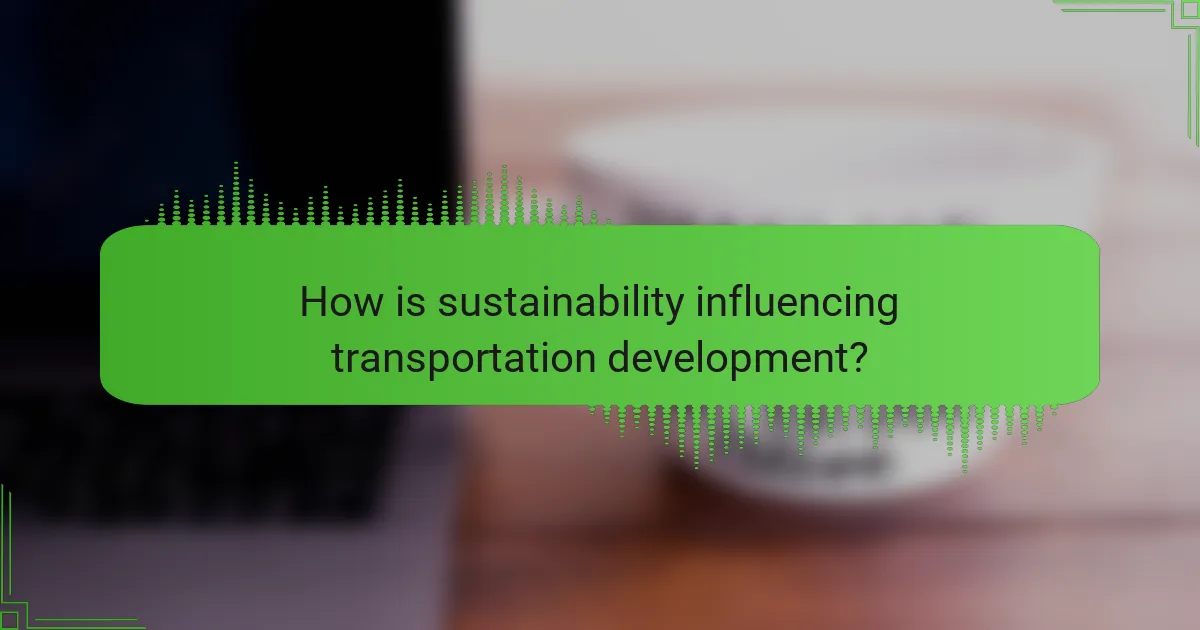
How is sustainability influencing transportation development?
Sustainability is profoundly shaping transportation development by prioritizing eco-friendly practices. Emerging technologies focus on reducing emissions and enhancing energy efficiency. For instance, electric vehicles, powered by renewable energy sources, are gaining traction. Additionally, public transit systems are evolving to integrate smart technologies, improving accessibility and reducing urban congestion. As a result, cities are adopting sustainable infrastructures, such as bike lanes and pedestrian-friendly zones, to promote greener transport options.
Which alternative fuels are gaining traction in the transportation sector?
Alternative fuels gaining traction in the transportation sector include electric, hydrogen, and biofuels. These options aim to reduce greenhouse gas emissions and enhance energy security.
Electric vehicles (EVs) are rapidly expanding, with global sales projected to reach 30% of all vehicles by 2030. Hydrogen fuel cells are emerging for heavy-duty transport, offering longer ranges and faster refueling times compared to batteries. Biofuels, derived from organic materials, are increasingly used in aviation and shipping, providing a renewable alternative to fossil fuels.
As a result, the shift towards these alternative fuels reflects a broader trend in sustainability and innovation within the transportation industry.
What are the benefits of public transportation in reducing carbon footprints?
Public transportation significantly reduces carbon footprints by decreasing the number of vehicles on the road. It offers a collective means of travel, which lowers greenhouse gas emissions per capita. For instance, buses and trains emit substantially less carbon dioxide per passenger compared to individual cars. As a result, cities that invest in public transit systems often see improved air quality and reduced traffic congestion. Additionally, enhanced public transportation can promote sustainable urban development, encouraging more people to choose eco-friendly travel options.
How are cities adopting green infrastructure for transportation?
Cities are increasingly adopting green infrastructure to enhance transportation sustainability. This includes integrating features like green roofs, permeable pavements, and urban forests, which improve air quality and reduce heat.
For instance, cities like Copenhagen and Singapore are implementing bike lanes surrounded by greenery, promoting cycling and reducing reliance on cars. Green public transport options, such as electric buses and trams, are also gaining traction, further decreasing carbon emissions.
Additionally, urban planners are focusing on mixed-use developments that encourage walkability. This design reduces the need for long commutes and fosters community engagement. As a result, these initiatives not only enhance transportation efficiency but also contribute to overall urban resilience.

What global trends are driving changes in transportation habits?
Global trends driving changes in transportation habits include sustainability, urbanization, and technological advancements. Increased awareness of climate change pushes consumers and governments toward eco-friendly transportation options. Urban areas are expanding, leading to greater demand for efficient public transit and shared mobility solutions. Emerging technologies like electric vehicles and autonomous systems are reshaping how people travel, enhancing convenience and reducing environmental impact. As a result, these trends are revolutionizing transportation norms worldwide.
How is urbanization affecting transportation demand?
Urbanization significantly increases transportation demand due to population growth and economic activity in cities. As urban areas expand, the need for efficient public transit systems and infrastructure upgrades becomes crucial.
Emerging technologies, such as electric vehicles and smart traffic management systems, are essential in addressing this demand. These innovations aim to reduce congestion and enhance sustainability. For instance, cities implementing automated public transport solutions report improved efficiency and reduced emissions.
Sustainability initiatives are becoming a priority as urbanization accelerates. Urban planners increasingly focus on integrating green transportation options, such as bike-sharing programs and pedestrian-friendly designs, to promote eco-friendly commuting.
Global trends indicate a shift toward multimodal transportation systems, combining various transport methods to meet diverse urban mobility needs. This approach enhances accessibility and reduces reliance on single-occupancy vehicles, aligning with sustainability goals.
What influence does remote work have on commuting patterns?
Remote work significantly reduces commuting patterns by decreasing the number of daily travelers. As remote work becomes more prevalent, many employees opt for flexible schedules, leading to less congestion and shorter travel times for those who still commute. Studies indicate that remote work can decrease commuting by up to 30%, contributing to reduced carbon emissions. This shift encourages cities to rethink transportation infrastructure and promote sustainable alternatives like cycling and public transit.
How are ride-sharing services transforming personal transportation?
Ride-sharing services are revolutionizing personal transportation by enhancing accessibility, reducing costs, and promoting sustainability. These services enable users to easily connect with drivers through apps, streamlining the travel experience.
The rise of electric vehicles within ride-sharing fleets is a key factor in reducing carbon emissions. Studies show that ride-sharing can decrease the number of cars on the road, leading to less congestion and pollution.
Additionally, ride-sharing platforms are integrating advanced technologies like artificial intelligence to optimize routes and improve efficiency. This innovation not only enhances user experience but also contributes to smarter urban planning.
As a result, ride-sharing services are shaping the future of transportation by prioritizing convenience, environmental responsibility, and technological advancement.
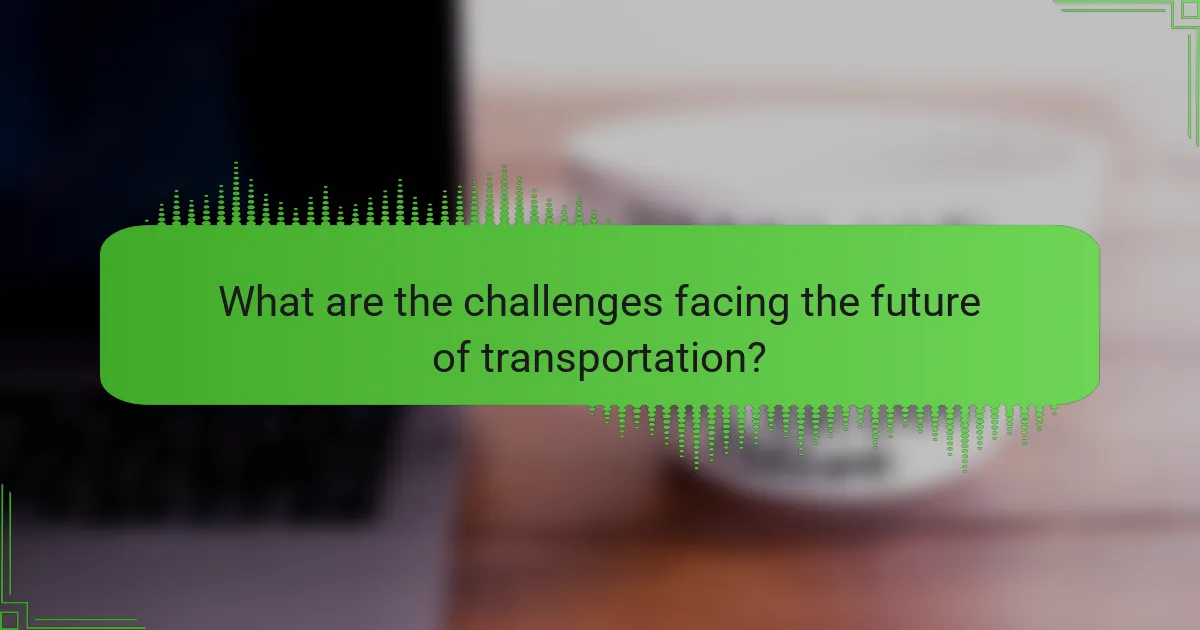
What are the challenges facing the future of transportation?
The future of transportation faces significant challenges, including technological integration, sustainability, and infrastructure adaptation. Emerging technologies like autonomous vehicles and electric transportation require substantial investment and regulatory frameworks. Additionally, achieving sustainability goals necessitates a shift in energy sources and materials. Infrastructure must evolve to accommodate new transport modes, creating potential disruptions. Lastly, global trends such as urbanization and climate change impose further complexities on transportation systems.
How do regulatory frameworks impact the adoption of new technologies?
Regulatory frameworks significantly influence the adoption of new technologies in transportation. They establish guidelines that ensure safety, environmental standards, and consumer protection. For example, stringent emissions regulations can accelerate the development of electric vehicles. Additionally, supportive policies may encourage investment in innovative infrastructure. As a result, the alignment of regulations with technological advancements fosters a conducive environment for sustainable transportation solutions.
What are the economic implications of transitioning to sustainable transportation?
Transitioning to sustainable transportation has significant economic implications, including job creation and reduced healthcare costs. The shift fosters innovation in green technologies, stimulating growth in related industries. As a result, cities can expect increased investment and improved public health outcomes. Additionally, sustainable transportation reduces dependence on fossil fuels, leading to more stable energy prices.
How does infrastructure readiness affect the implementation of innovations?
Infrastructure readiness significantly impacts the implementation of innovations in transportation. Well-developed infrastructure enables seamless integration of emerging technologies, such as electric vehicles and smart traffic systems.
For instance, cities with robust public transport networks can more effectively adopt autonomous vehicles. Conversely, inadequate infrastructure can hinder the deployment of sustainable solutions, delaying progress towards environmental goals.
Investment in infrastructure not only supports current innovations but also prepares for future advancements, ensuring adaptability and resilience in transportation systems.
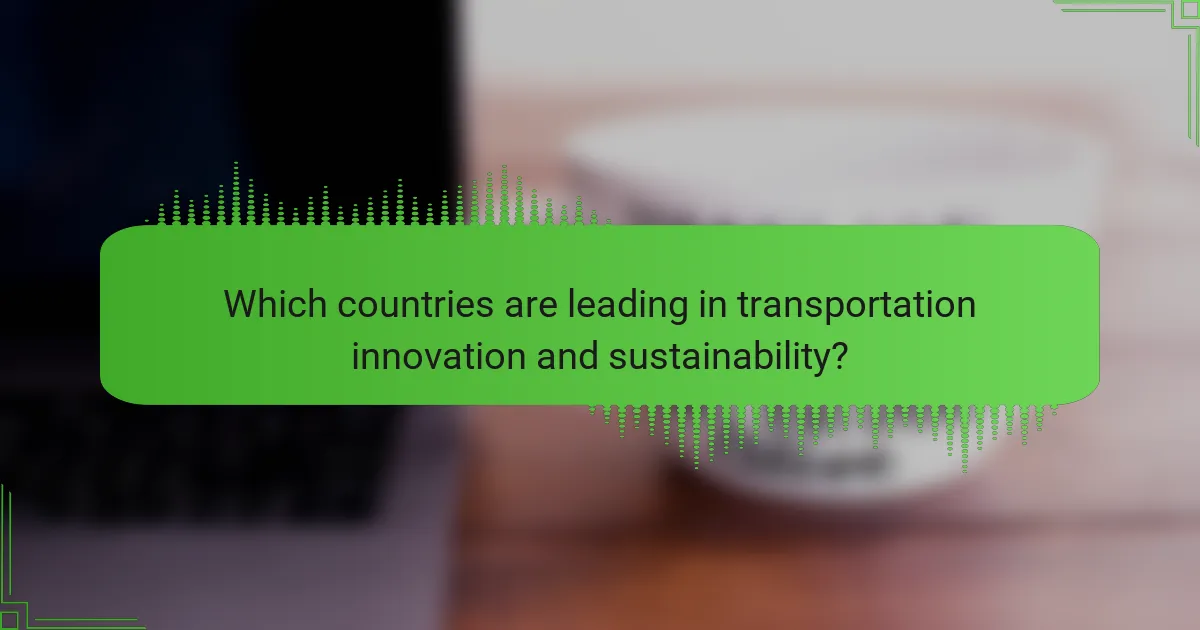
Which countries are leading in transportation innovation and sustainability?
Countries leading in transportation innovation and sustainability include Germany, the Netherlands, Sweden, and Japan. These nations prioritize electric vehicles, public transport efficiency, and renewable energy integration.
Germany invests heavily in electric mobility and autonomous driving technologies. The Netherlands excels in cycling infrastructure and smart traffic management systems. Sweden focuses on biofuels and sustainable public transport solutions. Japan is advancing in high-speed rail and hydrogen fuel technologies.
Together, these countries set benchmarks for global transportation sustainability through innovative practices and policies.
What lessons can be learned from successful global transportation initiatives?
Successful global transportation initiatives demonstrate the importance of innovation, collaboration, and sustainability. Key lessons include the need for integrating emerging technologies, such as electric and autonomous vehicles, to reduce emissions. Collaboration among governments, private sectors, and communities fosters effective solutions. Additionally, prioritizing public transportation enhances accessibility and reduces congestion. Finally, adopting sustainable practices ensures long-term viability and resilience against climate change.
How do cultural attitudes influence transportation technology adoption?
Cultural attitudes significantly shape transportation technology adoption by influencing public perception, acceptance, and usage. Societies valuing sustainability are more likely to embrace electric vehicles and public transit systems. In contrast, cultures prioritizing individualism may resist shared mobility solutions. For instance, countries with strong environmental movements often see rapid adoption of green technologies, while those with less emphasis on sustainability may lag. Additionally, cultural norms around urbanization impact preferences for transportation modes, with densely populated areas favoring efficient public transport. Understanding these cultural nuances is essential for advancing transportation technologies globally.
What partnerships are essential for advancing transportation solutions?
Strategic partnerships are crucial for advancing transportation solutions. Collaborations between government agencies, private companies, and research institutions drive innovation in sustainable transportation technologies.
Public-private partnerships facilitate funding for infrastructure projects and enable the integration of emerging technologies. For instance, collaborations with tech firms enhance data analytics for traffic management.
International alliances focus on sharing best practices and research findings, promoting global trends in electric vehicles and smart transit systems. These partnerships also address regulatory challenges and environmental standards.
Engaging with community organizations ensures that transportation solutions meet local needs and promote equity. This holistic approach fosters sustainable development and enhances the overall effectiveness of transportation systems.
What are the best practices for integrating new technologies into existing systems?
Integrating new technologies into existing systems requires strategic planning and execution. First, assess the compatibility of the new technology with current systems. Next, involve stakeholders early to gather insights and ensure buy-in. Implement pilot programs to test integrations before full deployment. Prioritize training for users to facilitate smooth transitions. Finally, continuously monitor performance and gather feedback to refine the integration process.

